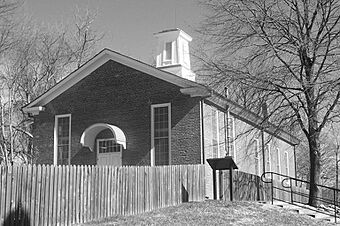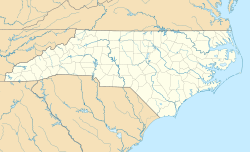St. Philips Moravian Church facts for kids
Quick facts for kids |
|
|
St. Philips Moravian Church
|
|

St. Phillips Moravian Church, 2007
|
|
| Location | E side, S. Church St. near Race St., Old Salem, North Carolina |
|---|---|
| Area | less than one acre |
| Built | 1861 |
| Built by | Charles Houser George Swink |
| Architectural style | Greek Revival |
| NRHP reference No. | 91001170 |
| Added to NRHP | September 3, 1991 |
St. Philips Moravian Church is a very important historical building in North Carolina. It is the oldest church building in the state that was built by and for African American people and is still standing today. This special Moravian church was built in 1861 in a historic area called Old Salem.
The church building was made bigger in 1890. People used it regularly for church services until 1952. Later, in 2004, it was carefully fixed up by Old Salem Museums & Gardens. Now, it is a place where people can learn about history, and church services are still held there every week.
Contents
History of St. Philips Church
Early Beginnings (1822-1861)
The story of St. Philips Moravian Church began in 1822. At that time, a group of Black church members formed their own congregation. They built a log church building south of a place called the 'Strangers Graveyard'. This graveyard had been set aside as a cemetery for African Americans in 1816.
From 1827 to 1831, white Moravian women, known as Single Sisters, taught Sunday school at the church. However, a state law was passed that made it illegal to teach enslaved people how to read and write. This law stopped the Sunday school classes for a while.
Building the Brick Church (1861)
As the congregation grew, the Moravian leaders decided to build a larger church. In 1861, they built the brick church that you see today. It was built just east of the graveyard.
A very important event happened at this church on May 21, 1865. A Union Army officer, Rev. Seth G. Clark, stood in the St. Philips pulpit. He read General Orders 32, which announced that enslaved people were now free. This was a huge moment for the community.
Changes and New Names (1890-1999)
In 1890, the church building was made even larger. A new section was added to the front. This addition included a central hallway and classrooms on the lower floor. Above these classrooms was a big room that could be opened up to the main church area or closed off for more classes.
For many years, the brick church was known as the Moravian "Negro congregation." But in December 1913, during a special church service called a lovefeast, it was given a new name. Bishop Edward Rondthaler officially named it St. Philips.
Because of its important history, the church building was added to the National Register of Historic Places in 1991. This means it is recognized as a significant historical site. Later, in 1999, the original log church from 1823 was rebuilt exactly where it first stood.



